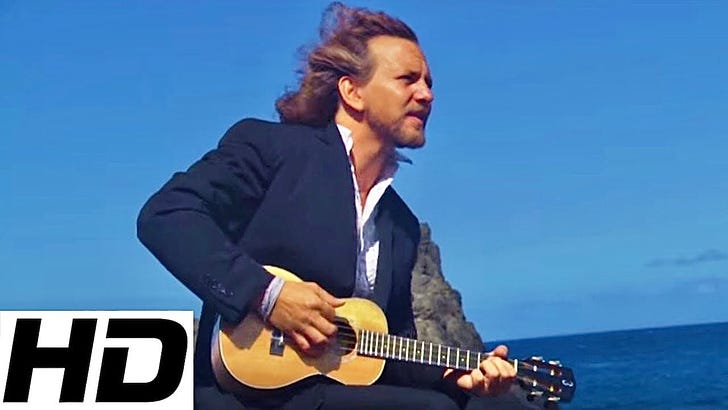Last week’s Bonus Round: “Hard Sun” is a cover song by Pearl Jam lead singer Eddie Vedder and was part of the the soundtrack for the 2007 film “Into The Wild”. The song was written by Gordon Peterson, known by the stage name Indio, who dropped out of public view after his first album, on which “Hard Sun” appears. Peterson re-emerged into the public when he filed a lawsuit in December 2009 against Pearl Jam's Eddie Vedder, alleging infringement resulting from usage and alteration of "Hard Sun" without Peterson's permission, although Universal Music, Peterson's former label, granted permission.[6][7] The suit against Vedder was dismissed,[8] while a simultaneous suit against Universal was dropped after Universal and Peterson reached an undisclosed settlement.[9] Credit (in part) Wikipedia
For the last few weeks we’ve been exploring a variety of topics relating to music: recording, dynamics in playing, performing and recording, guitar maintenance and others.
As we approach the one year anniversary(!) of Michael Acoustic on SubStack I want to re-engage on a sort of project that I started and then let fall by the wayside. Next week I’ll publish a series of “pointer” posts, sort of an index of series of topics I’ve done over the past year. These will be kind of “more or less” because I tend to introduce a topic or concept and then return to it as it relates to a new topic. The idea is to provide a basic understanding of a concept and then weave that concept in with a new topic (example: music theory as a language among musicians > how to use that language in a jam session or rehearsal). So I’ll try to organize “series” into a collection of related links to my earlier posts each day next week without other content so you can review anything in the context of the broader theme. Hopefully helpful to some newer subscribers (and thank you to all so much for your support!).
For this week, I’m going to “hit the links” (not on an actual golf course - that picture and the many memes it’s spawned kinda cracks me up, though) - this isn’t JUST me being lazy, cuz I’ll try to explain the “why” of a particular link as we go along. Rather than sheer laziness, it’s actually so you get the “real scoop” from peeps who are more experienced than I am, and are the ones I learn things from. All of these folks learned from someone else, and some from hard won experience in the “biz”. Valuable stuff.
So here we go: first, one of my favorite guitarists who does a lot of explaining in easy to understand terms, making music theory more accessible in practical terms, rather than only as esoteric theory. I think that helps my (and your) own playing, but also helps your conversations with guitar instructor, friends you jam with, bandmates, and the audio engineer/producer you may work with to master your recordings. As a side note, all of the music theory classes I took at a local college were co-classified as “audio engineering” courses - yep, to earn a basic degree in audio engineering, music theory was a bedrock requirement!
This is the great Sean Daniel in a Rumble video in his “Guitar Control” series - I think he has a YouTube channel and a paid subscription course as well.
What Mr. Daniel does here is sneaky smart! In easy-to-follow language (and you can skip back and forth in the video) he introduces several concepts and then brings them all together! First, if you’re stuck in the cowboy chords using only the top 3 or 4 frets, he explains how to find the root notes on the low E and the A string to make shapes you can move all over the fretboard and how you can use that knowledge to construct and play arpeggios of the chord, meaning playing the notes of a chord as individual notes rather than a strum. Next, there’s some basic, but not intimidating, music theory as he goes over the basics of a simple triad chord, Am, and then talks about the Am pentatonic scale. I haven’t touched on penatatonic scales on here much because it’s definitely a topic for discussion with your guitar instructor and will inevitably (probably) lead to something called the “CAGED” system, which is even deeper in guitar instructor territory. That’s all definitely a “the birds and the bees” of guitars type of conversation that you should have, just not with me. Worth the 10 minutes, even if you’re at a very basic level, if only for the things to discuss at your next lesson.
Next, a couple of videos (Parts 1 and 2 of a series) by Mr. Tony Van Veen of Disc Makers/CD Baby on where streaming royalties of songs you listen to (and of your songs once they’re on a streaming service) end up, mostly. Hint: it’s mostly not with you…. But, there may be hope for a change in things coming - worth watching both.
A great article from American Songwriter - if you’re writing your own songs, either music first, then fitting lyrics to the music, or lyrics first, then setting them to music, this is a good place to start. As guitarists, we tend to start out thinking in terms of chords - only natural, the guitar is (like the piano) a chordal (harmonic) instrument, capable of playing more than one note on a given beat or at a time (that’s harmony rather than melody, which is a single note at a time played on a single beat, or sustained (held) over several beats, then followed by more single notes at a time). When we strum across the strings, we play several notes at a time (harmony), when we finger- or flat- pick, or add “voicings” to chords, we play a single note at a time and create a melody. We may have a melody in our head (how we’re going to sing the song we’re writing in chord progressions if that’s how you do it - that’s how I do it), but capturing that if you don’t write in scored melodies (I don’t) will leave you only with a vocal recording as a reference for those who may cover your song. That’s why copyrighting your sound (audio or video) master recording is really important - it establishes your arrangement, which is an essential part of the rights you own as the composer or co-writer and publisher.
Along those lines is this video, again from Tony Van Veen (his YouTube is definitely a cornucopia of great advice for recording/performing artists and songwriters) and addresses the need to own the copyright of your sound recording.
Own Your Sound Recording - Copyright it!
Berklee Online (a service of Berklee College Of Music) is a source for free handbooks and other resources on a variety of music and music business related topics (sorta free - you’ll get a LOT of promotional emails from them to sign up for their online courses, which may not be a bad choice, Berklee is one of the premier music colleges in the world - literally -they have branch campuses in other countries!). The handbooks are pretty informative and useful. Your mileage, however, may vary.
Another from American Songwriter - an interesting approach to jump start a song when you’re looking for ideas for lyrics and maybe your songs are all starting to sound the same, especially if you take the “music first, then lyrics” approach. The idea is to write new lyrics to an existing song to analyze a song that someone else wrote in order to hear a different approach to rhythm, meter, rhyme structure, maybe syllable counts than you’re used to. Take care not to copy the melody, arrangement and lyrics, but try to get out of your familiar comfort zones and habits with different rhythms, tempos, timing, line and syllable counts to create something different.
From Songtown, sometimes learning from the mistakes of others can be a good way to avoid making them yourself. Article by Marty Dodson, who speaks of his own experiences. Good read.
We’ve talked a little about using suspended chords as “voicings”, a way to play a basic chord with a little different sound, often just by lifting or placing a finger on a string at a place that’s a little different from a basic chord. This article starts with a theory refresher and is a tad long, but playing suspended chords, especially with a “dawdle” where the suspended part comes in or leaves as a kind of quick slurred version adds a tremendous amount of interest to your playing. As I recall, we used the intro to the acoustic version of Counting Crows great song “Angels Of the Silences” a few weeks back as an example. Worth another listen to the first few measures to hear the sound.
So nine links on a variety of things this Substack is about: guitars, playing guitars, songwriting, copyrights, recording, the music business and some other stuff you can use on your journey.
Bonus Round: That’s not a typo in the subtitle. A “southern gothic” song featuring a bird noted for being “blue” in the title.
Cheers, and keep playing!
Michael Acoustic





